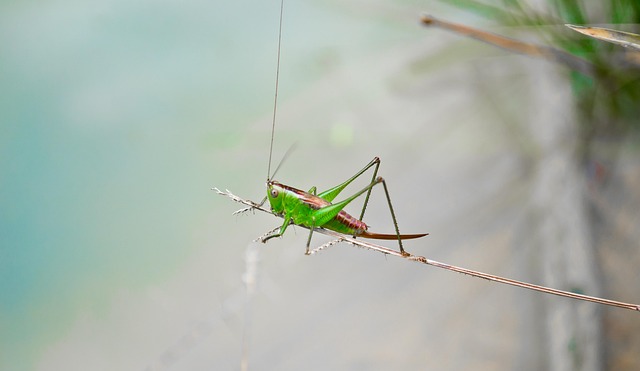Cricket infestations in warmer climates require immediate, effective cricket infestation treatment due to their rapid growth and adaptability to warm, humid environments with abundant food sources. Entry points must be sealed, moisture levels reduced, and targeted pest control implemented both indoors and outdoors. For stubborn cases, professional services offer heat treatments, fumigation, ongoing monitoring, and strategic insecticide applications. Outdoor management techniques like addressing breeding grounds, maintaining drainage, mowing grass short, removing clutter, using screens, and cleaning areas reduce infestations significantly. Proactive prevention includes eliminating habitats and food sources through sanitation, ventilation, regular inspections, and approved cricket infestation treatment methods.
Crickets can turn from a harmless summer sound into a persistent indoor nuisance, indicating a growing infestation. This comprehensive guide tackles cricket infestation treatment head-on. We break down the problem into its core elements: understanding these insects’ behavior and habitat, implementing effective indoor strategies, exploring outdoor management techniques, and providing long-term preventive measures. By following these steps, you can reclaim your space from crickets once and for all.
Understanding Cricket Infestations: Behavior and Habitat
Cricket infestations can quickly transform from a minor annoyance to a significant pest control issue, especially in warmer climates. Understanding their behavior and habitat is crucial when it comes to effective cricket infestation treatment. These insects are highly adaptable and thrive in both indoor and outdoor environments. They prefer warm, humid conditions and are often attracted to areas with readily available food sources, such as gardens and garbage dumps.
In homes, crickets commonly seek shelter in dark, secluded places like basements, attics, and crawl spaces. They can enter through tiny cracks and gaps around windows, doors, or utility pipes. Once inside, they reproduce rapidly, with female crickets laying eggs in batches of up to 50 at a time. Effective cricket infestation treatment involves identifying and sealing these entry points, reducing moisture levels, and implementing targeted pest control measures tailored to both indoor and outdoor environments.
Effective Indoor Treatment Strategies
Cricket infestation treatment requires a multi-faceted approach, especially when dealing with indoor spaces. Effective strategies include identifying and sealing entry points to prevent further invasions. Regular vacuuming and sweeping help remove cricket eggs and nymphs hidden in corners and crevices. Additionally, using insecticides specifically designed for crickets can provide targeted control, ensuring that every stage of the insect’s life cycle is addressed.
For persistent indoor cricket infestations, professional pest control services offer advanced solutions. Heat treatments and fumigation are used to eliminate adults and disrupt breeding cycles. It’s crucial to combine these methods with ongoing monitoring and maintenance to break the infestation cycle once and for all, providing a lasting cricket-free environment.
Outdoor Management Techniques for Cricket Control
To effectively manage a cricket infestation, outdoor techniques play a pivotal role. One proven method involves targeting their breeding grounds. Crickets breed in moist, warm environments, so addressing these conditions is key. Maintaining proper drainage and reducing standing water around your property can significantly deter them. Additionally, keeping grass mowed short and removing cluttered debris creates less favorable habitats.
Another outdoor strategy is the use of physical barriers. Installing screens on windows and doors prevents adult crickets from entering your home. Seal any cracks or gaps where they might find entry points. Regularly cleaning outdoor areas, including patios and porches, reduces cricket attractions by eliminating resting spots and food sources. These combined outdoor management techniques can substantially reduce cricket infestations, providing a more comfortable living environment.
Preventive Measures: Long-term Solutions for Cricket Infestation
To prevent a cricket infestation, it’s crucial to implement long-term strategies that target their habitat and food sources. Starting outdoors, seal any cracks or gaps around windows, doors, and foundations to limit entry points. Regularly clean outdoor areas, removing debris and storing items like woodpiles off the ground and away from structures. Maintaining a well-trimmed lawn and removing tall grasses provides less hiding spots for crickets.
Internally, focus on sanitation and ventilation. Keep floors, especially kitchens and food storage areas, spotless to eliminate attracting elements. Ensure proper ventilation in attics and crawl spaces to reduce humidity levels, as crickets thrive in moist environments. Regular inspections can help identify early signs of an infestation, allowing for swift action using approved cricket infestation treatment methods before populations escalate.
Managing a cricket infestation requires a multi-faceted approach that combines indoor and outdoor strategies. By understanding the behavior and habitat of crickets, you can implement effective treatments both within your space and in the surrounding environment. Integrating these methods offers long-term solutions for cricket infestation control, ensuring a more comfortable and pest-free living or working area. For optimal results, consider combining indoor treatments like heat or chemical applications with outdoor management techniques such as habitat modification and preventive measures to completely eradicate and prevent future infestations of these pesky insects.
